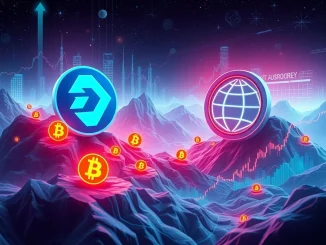
The world of finance is experiencing a profound shift, and at its heart lies Bitcoin. This pioneering digital currency has not only captured the attention of investors and tech enthusiasts but is actively reshaping global financial systems. With its market capitalization soaring past the $1 trillion mark, Bitcoin stands as a testament to the power of decentralization and innovation. But what exactly makes Bitcoin such a transformative force, and how does its underlying technology drive this monumental change?
Understanding Bitcoin: The Power of a Decentralized Blockchain
At its core, Bitcoin represents a radical departure from traditional financial structures. Unlike the fiat currencies we use daily, such as the U.S. dollar or euro, Bitcoin operates entirely without intermediaries like banks or governments. This fundamental principle of decentralization is what truly sets it apart. Imagine a financial system where you can send money directly to anyone, anywhere in the world, without needing a third party to approve or facilitate the transaction. That’s the promise of Bitcoin.
- Peer-to-Peer Network: Transactions occur directly between users.
- Independence: Operates free from central authority or government oversight.
- Transparency: All transactions are recorded on a public ledger.
The backbone of this system is the decentralized blockchain. This distributed ledger technology ensures that every transaction is securely recorded, transparently verifiable, and immutable. Think of it as a continuously growing chain of ‘blocks,’ where each block contains a list of transactions, and once added, it cannot be altered. This distributed nature means no single entity controls the network, making it highly resistant to censorship and manipulation. Furthermore, Bitcoin’s capped supply of 21 million units introduces scarcity, a key factor contributing to its perceived value and appeal as a store of value.
From Genesis to Global: Bitcoin’s Journey to a Trillion-Dollar Crypto Market Cap
Bitcoin’s journey from a theoretical concept to a global financial phenomenon is nothing short of remarkable. Its origins trace back to 2008, amidst a global financial crisis, when an anonymous individual or group known as Satoshi Nakamoto published the Bitcoin whitepaper. This groundbreaking document outlined the vision for a decentralized digital currency, laying the groundwork for what would become a new era in finance. The network officially launched in January 2009 with the mining of the ‘Genesis Block’ – the very first block on the Bitcoin blockchain.
Early milestones quickly followed, solidifying its practical applications:
- 2010: The first recorded Bitcoin transaction occurred, famously involving 10,000 BTC for two pizzas.
- 2011: The emergence of cryptocurrency exchanges began to facilitate easier buying, selling, and trading of Bitcoin.
- Ongoing Innovation: Solutions like the Lightning Network have been developed to enhance Bitcoin’s scalability and transaction speed, addressing early limitations and paving the way for wider adoption.
The culmination of this journey was witnessed in February 2021 when the crypto market cap of Bitcoin officially surpassed an astonishing $1 trillion. This milestone underscored its growing acceptance and influence in the global economy, signaling its transition from a niche technology to a recognized asset class and a significant player in the financial landscape.
The Mechanics Behind the Magic: How Bitcoin Functions as a Digital Currency
Understanding how Bitcoin operates involves delving into its ingenious technical framework, which relies on cryptographic validation and consensus mechanisms. When a user initiates a transaction, it’s broadcast across the entire network. This transaction then awaits validation by ‘miners’ through a process known as Proof-of-Work (PoW).
Here’s a simplified breakdown:
- Transaction Broadcast: A user sends Bitcoin, and this request is sent to all nodes on the network.
- Mining Competition: Miners compete to solve a complex cryptographic puzzle. This puzzle requires significant computational power.
- Block Creation: The first miner to solve the puzzle earns the right to add a new block of validated transactions to the blockchain.
- Reward: The successful miner receives newly minted bitcoins as a reward, alongside transaction fees. This process is how new bitcoins are introduced into circulation.
This PoW process not only secures the network by making it computationally expensive to alter past transactions but also ensures the integrity of all exchanges, preventing issues like ‘double-spending.’ The blockchain’s tamper-proof design, where each block is cryptographically linked to the previous one, reinforces its security and transparency, making Bitcoin a truly robust digital currency.
The Role of Mining and Its Considerations
Mining remains central to Bitcoin’s ecosystem. However, it has also raised concerns, primarily regarding energy consumption due to the computational power required. To mitigate individual risks and increase their chances of earning rewards, miners often join ‘mining pools’ to combine their resources. While efficient, this practice has sparked debates over potential centralization of mining power. The network’s difficulty adjusts approximately every 2,016 blocks (roughly every two weeks) to maintain a consistent block time of about 10 minutes, ensuring a steady issuance of new bitcoins and maintaining network security.
Securing Your Digital Currency: Wallets and Keys
Transactions on the Bitcoin network are secured through private and public key cryptography. Users store their bitcoins in digital wallets, which generate these cryptographic keys to authorize transactions. Your ‘private key’ is like a secure password; it must be safeguarded diligently, as losing it results in permanent loss of access to your funds. The ‘public key’ is derived from your private key and acts as your Bitcoin address, allowing others to send you funds.
Wallet types offer varying levels of convenience and security:
- Software Wallets (Hot Wallets): Connected to the internet (e.g., desktop, mobile apps). Convenient for frequent transactions but more susceptible to online threats.
- Hardware Wallets (Cold Storage): Physical devices that store your private keys offline. Highly secure against cyber threats, ideal for long-term storage.
- Paper Wallets (Cold Storage): Private and public keys printed on paper. Offer excellent security if stored properly, but require careful handling to avoid damage or loss.
For significant holdings, hardware wallets and other cold storage solutions are generally favored for their protection against cyber threats.
Reshaping Financial Systems: Bitcoin’s Impact and Future Potential
The Bitcoin ecosystem extends far beyond simple transactions, encompassing a complex web of exchanges, investors, developers, and regulators. Exchanges are crucial platforms that facilitate the buying, selling, and trading of bitcoins, serving as gateways between traditional finance and the crypto world. Investors view Bitcoin as both a speculative asset and, increasingly, as a potential store of value and a hedge against inflation, particularly given its finite supply.
The Regulatory Landscape: A Double-Edged Sword
Regulatory frameworks for Bitcoin remain a contentious and evolving issue globally. Governments are grappling with the challenges posed by Bitcoin’s pseudonymity and decentralized nature. Some jurisdictions, like El Salvador in 2021, have taken the bold step of adopting Bitcoin as legal tender, integrating it into their national economies. However, the absence of clear, unified global regulations creates uncertainty for businesses and investors, yet it also highlights Bitcoin’s disruptive potential to traditional financial systems.
Risks and Best Practices for the Digital Age
Despite its triumphs, Bitcoin carries inherent risks that users and investors must acknowledge. Its price volatility is well-known, leading to significant fluctuations in value. Regulatory scrutiny continues to be a concern, with potential crackdowns impacting market sentiment. Technological vulnerabilities, though rare, are always a possibility, and the environmental concerns related to energy consumption for mining persist. Best practices emphasize:
- Thorough Research: Understand the technology and market dynamics.
- Diversified Portfolios: Avoid putting all your capital into one asset.
- Proactive Security Measures: Use strong passwords, two-factor authentication, and secure wallet solutions.
The Road Ahead: Bitcoin’s Evolving Role and Future Potential
Looking ahead, advancements in blockchain technology and increased mainstream adoption are expected to further enhance Bitcoin’s utility and stability. While challenges such as scalability and energy efficiency remain ongoing areas of development and debate, the decentralized nature of Bitcoin positions it as a transformative force in digital finance. Its ability to operate outside traditional control offers a compelling alternative for global transactions and wealth preservation.
As the ecosystem continues to evolve, stakeholders must find a balance between fostering innovation, ensuring sustainability, and navigating the complex landscape of regulatory compliance. Bitcoin’s journey is far from over; it continues to challenge, innovate, and inspire, promising a future where financial systems are more accessible, transparent, and user-controlled.
Frequently Asked Questions (FAQs)
1. What makes Bitcoin different from traditional money?
Bitcoin is a decentralized digital currency, meaning it operates without a central bank or government control. Unlike traditional fiat money, which is issued and regulated by authorities, Bitcoin is managed by a peer-to-peer network and secured by cryptography, allowing for direct transactions between users without intermediaries.
2. How does Bitcoin’s blockchain technology ensure security?
The blockchain is a distributed public ledger that records all Bitcoin transactions. Each new block of transactions is cryptographically linked to the previous one, creating an immutable chain. This distributed and tamper-proof design, validated by a global network of miners, makes it incredibly difficult for anyone to alter or fake transactions, ensuring high security.
3. What is Bitcoin mining, and why is it important?
Bitcoin mining is the process by which new bitcoins are introduced into circulation and new transactions are added to the blockchain. Miners use powerful computers to solve complex cryptographic puzzles (Proof-of-Work). The first miner to solve the puzzle gets to add a new block to the blockchain and receives a reward in newly minted bitcoins and transaction fees. Mining is crucial for securing the network, validating transactions, and maintaining the decentralized nature of Bitcoin.
4. Is Bitcoin a good investment?
Bitcoin is considered a highly volatile asset, meaning its price can fluctuate significantly. While many investors view it as a potential store of value or a hedge against inflation due to its limited supply, it also carries risks such as regulatory uncertainty, technological vulnerabilities, and market speculation. It’s essential to conduct thorough research, understand the risks, and consider a diversified investment portfolio.
5. How do I store Bitcoin securely?
Bitcoin is stored in digital wallets, which hold your cryptographic private keys. These keys are essential for accessing and spending your Bitcoin. Wallets come in various forms: software wallets (hot wallets like mobile apps or desktop programs) are convenient for everyday use but are connected to the internet. Hardware wallets (cold storage) are physical devices that store keys offline, offering superior security for larger holdings. Paper wallets also offer cold storage by printing keys, but require careful physical security.
6. What are the environmental concerns associated with Bitcoin?
The primary environmental concern stems from Bitcoin’s Proof-of-Work (PoW) mining process, which requires significant computational power and, consequently, a substantial amount of electricity. Critics argue that this energy consumption contributes to carbon emissions. However, proponents point to increasing use of renewable energy in mining and ongoing efforts to develop more energy-efficient blockchain solutions.



